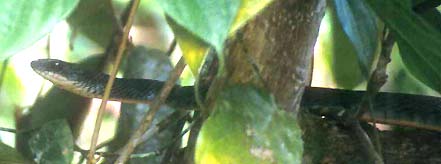| Hylomys suillus LESSER GYMNURE |
2003 |
One dashing in and out of the rubbish heap near Timpohon Gate at end
of summit road on GK. Resembles a large dark shrew with naked tail. |
| Tupaia montana MOUNTAIN TREESHREW |
2003 |
One in the forest on Kiva View trail seemed most likely to be this
species. |
| Cynocephalus variegatus COLUGO [Flying Lemur] |
2003 |
Individuals were seen twice on night drives at BRL; possibly the same
one was seen both times although several nights apart. One was heard calling
another night. The one seen was hitching its way high up a straight thin
limbless tree trunk and we had great views of the head — looks like a mouse
deer — and the extensive gliding membrane that encloses the back legs and
tail. Just a fabulous mammal! Colugo is often called "flying lemur" but
it is not related to lemurs at all. It is in its own order (Dermoptera)
and there are just two species: this one and another in s. Philippines. |
| Rhinolophus sp.? (borneensis?) BORNEAN HORSESHOE BAT |
2003 |
The many bats seen in flight inside the "bat caves" at Poring apparently
included Horseshoe Bats; perhaps borneensis. This information comes
primarily from V. Dinets. |
| Murina suilla? LESSER TUBE-NOSED BAT ? |
2003 |
A day-flying bat foraging over a small river at Mulu may have been
this species. We watched it daily at close range from the boardwalk bridge
enroute to Deer Cave. |
| Tadarida plicata WRINKLE-LIPPED FREE-TAILED BAT |
2003 |
This is the abundant bat seen on the "bat flights" out of Deer Cave
at Mulu. Presumably it is also the species roosting densely in Gomantong
Cave. |
| Presbytis hosei HOSE'S LANGUR |
2003 |
Small party near Deer Cave in Mulu. |
| Presbytis rubicunda MAROON LANGUR [Red Leaf Monkey] |
2003 |
Small parties watched at close range; video'd & photo'd on 2 of
8 days at BRL. Just great little monkeys! |
| Presbytis cristata SILVERED LANGUR |
2003 |
Small parties seen each day spent on the Kinabatangan River at Sukau;
another family group at BRL was considered rare there. |
| Nasalis larvatus PROBOSCIS MONKEY |
2003 |
This is a major attraction along the Kinabatangan River at Sukau. We
saw, video'd, and photo'd good numbers (up to 50+/day) feeding in the riverside
trees. Fabulous monkeys with much variation in the size of their noses.
They are endemic to Borneo; known only from three general locales; and
are in decline. |
| Macaca fascicularis LONG-TAILED MACAQUE |
2003 |
Widespread and common in lowland Sabah. Seen daily at Sukau; more at
Poring and BRL; and common on Pulau Tiga. Some large males can be very
aggressive. |
| Macaca nemestrina PIG-TAILED MACAQUE |
2003 |
A few came to the feeding station at Sepilok (including an alpha male)
and a few more were seen at BRL. |
| Hylobates muelleri BORNEAN GIBBON |
2003 |
Heard every day around BRL and they could be seen in the early morning
there with a little effort. Good views of parties along the Nature trail
there and along the access road. Their calls epitomize "wild Borneo." |
| Pongo pygmaeus ORANG-UTAN |
2003 |
Four semi-wild orangs of varying ages came to the feeding station in
Sepilok; we found another deep inside the forest the next morning. We are
told that all these are rehabilitated orphans from various sources. Truly
wild Orang-Utan [pronounced "O-ron-oo-ton" not "O-rang-a-tang"]
were seen on 4 of our 8 days at BRL. These were: a family group (male;
female; baby) that had used a tree nest along the access road near the
lodge; two different youngsters inside the forest on different days (Rita
has video); and an absolutely huge adult male feeding high in a forest
tree on the Sapa Babandril trail our final morning. He was as big as a
male gorilla and had huge and round flat cheeks. When he saw us he began
a series of complaining vocalizations that were wonderful to hear. We heard
orangs on several other days that we did not see them. For tourists that
visit BRL seeing an Orang-Utan is a prime goal. But many failed since they
only stayed 2 or 3 nights. Experiencing wild orangs is among the highlights
of this trip. |
| Ratufa affinis GIANT SQUIRREL |
2003 |
Single huge squirrels were seen at Poring and at BRL. |
| Callosciurus prevostii PREVOST'S SQUIRREL |
2003 |
Good numbers daily at Mulu. |
| Callosciurus baluensis KINABALU SQUIRREL |
2003 |
Seen most days at GK. |
| Callosciurus orestes BORNEAN BLACK-BANDED SQUIRREL |
2003 |
Almost daily at GK. |
| Sundasciurus hippurus HORSE-TAILED SQUIRREL |
2003 |
One inside forest at BRL. |
| Sundasciurus jentinki JENTINK'S SQUIRREL |
2003 |
Seen most days at GK. |
| Dremomys everetti BORNEAN MOUNTAIN GROUND-SQUIRREL |
2003 |
Seen along summit trail above Timpohan Gate; some begging for food
from hikers. |
| Exilisciurus exilis PLAIN PYGMY SQUIRREL |
2003 |
Common at Mulu and this includes at the resort. They are very fast
and constantly moving! Very tiny beasts. |
| Exilisciurus whiteheadi WHITEHEAD'S PYGMY SQUIRREL |
2003 |
One seen at GK. |
| Aeromys tephromelas BLACK FLYING-SQUIRREL |
2003 |
Several watched on night drives at BRL; one seen to glide out into
the night! |
| Aeromys thomasi THOMAS'S FLYING-SQUIRREL |
2003 |
This all-red flying-squirrel seen on 2 of 6 night drives at BRL. |
| Petaurista petaurista RED GIANT FLYING-SQUIRREL |
2003 |
This big red flying-squirrel with black tip to tail was seen on 3 of
6 night drives at BRL. |
| Vierra tangalunga MALAY CIVET |
2003 |
One watched as it walked across the access road at BRL during a night
drive. |
| Paradoxurus hermaphroditus COMMON PALM CIVET |
2003 |
One on night drive out beyond the BRL gate. It was foraging on the
ground. |
| Arctogalidia trivirgata SMALL-TOOTHED PALM CIVET |
2003 |
Three different ones were seen on night drives on 3 nights at BRL.
All were feeding in flowering shrubs well up off the ground. We had some
really close views of one of them. |
| Cynogale bennettii OTTER-CIVET |
2003 |
This was the "best" mammal of the trip from the standpoint of rarity.
It is a "little known" terrestrial and aquatic predator. We saw it during
an extended night drive at BRL but well out beyond the BRL gate. It was
foraging in a small stream running through a gulley below the road. We
had good views of its otter-like paws, broad face, and all-dark pelage.
A real treat. |
| Herpestes brachyurus SHORT-TAILED MONGOOSE |
2003 |
One crossed the BRL access road during the day. |
| Sus barbatus BEARDED PIG |
2003 |
On several nights at BRL a wild pig would come to the back door of
the kitchen for hand-outs. Others were seen late one afternoon crossing
the access road there. |
| Tragulus javinicus LESSER MOUSE-DEER |
2003 |
Seen on about half of the night drives at BRL; several times studied
at length. They seemed oblivious to the truck and spotlight as they foraged
in the brush next to the road. On one night a youngster came to the lodge
itself and was pitifully crying off the main deck during dinner. |
| Tragulus napu GREATER MOUSE-DEER |
2003 |
None. |
|
1988 |
One watched inside the forest at DVFC was believed to be this species
on its very uniform pattern. |
| Muntiacus muntjak RED MUNTJAC |
2003 |
None seen but surprised muntjac were heard barking a couple times at
BRL. |
|
1988 |
A muntjac inside the forest at DVFC was thought to be this species
as it was "darker brown" than what was thought to be the next species. |
| Murtacus atherodes BORNEAN YELLOW MUNTJAC |
2003 |
None for sure; see above on those heard. |
|
1988 |
A "pale tan-colored" muntjac that crossed the road at DVFC was thought
to be this species. |
| Cervus unicolor SAMBAR |
2003 |
A pair grazed on the grass outside our room at BRL every night. Others
seen on night drives or during the day when they crossed the access road. |
Droppings of Asian Elephant Bransbury, J. 1993. A Birdwatcher's Guide to Malaysia. Waymark
Publ., Adelaide, Australia.
Chantler, P. 2000. Swifts: A Guide to the Swifts and Treeswifts of the
World. 2d ed. Yale Univ. Press, New Haven, CT.
Colenutt, S. 2002. Little-known Oriental bird: Bornean Bristlehead.
Oriental Bird Club Bull. 35:75-77.
Dutson, G., R. Wilkinson, and B. Sheldon. 1991. Hook-billed Bulbul Setornis
criniger and Grey-breasted Babbler Malacopteron albogulare at
Barita Ulu, Kalimantan. Forktail 6:78-82.
Francis, C.M., ed. 1984. Pocket Guide to the Birds of Borneo, from plates
in B.E. Smythies, Birds of Borneo, 3d ed. The Sabah Society, Kota
Kinabalu.
Harrap, S. 1994. Little-known Oriental bird: Kinabalu Friendly Warbler.
Oriental Bird Club Bull. 20:24-27.
Inger, R.F., and T.F. Lian. 1996. The Natural History of Amphibians
and Reptiles in Sabah. Natural Hist. Publ. (Borneo) Sdn. Bhd., Kota Kinabalu.
Kurata, S. 1976. Nepenthes of Mount Kinabalu. Sabah National Parks publ.
2, Kota Kinabalu.
Lambert, F., and M. Woodcock. 1996. Pittas, Broadbills, and Asities.
Pica Press, East Sussex, U.K.
MacKinnon, J. 1974. In Search of the Red Ape. Holt, Rinehart & Winston,
New York.
MacKinnon, J., and K. Phillipps. 1993. A Field Guide to the Birds of
Borneo, Sumatra, Java, and Bali. Oxford Univ. Press, Oxford.
Payne, J., C.M. Francis, and K. Phillipps. 1985. A Field Guide to the
Mammals of Borneo. The Sabah Society, Kota Kinabalu.
Showler, D.A. 1992. Birdwatching areas: Danum Valley Conservation Area,
Sabah, Malaysia. Oriental Bird Club Bull. 16:26-31.
Steubing, R.B., and R.F. Inger. 1999. A Field Guide to the Snakes of
Borneo. Natural Hist. Publ. (Borneo) Sdn. Bhd., Kota Kinabalu.
Wheatley, N. 1996. Where to Watch Birds in Asia. Princeton Univ. Press,
Princeton, N.J.
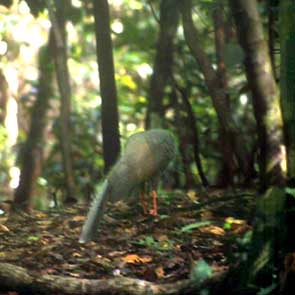 Male
Great
Argus on trail at BRL (right).
Male
Great
Argus on trail at BRL (right).
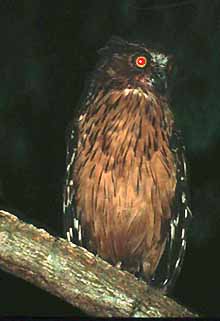 A
pair present nightly on the badminton court at DVFC; I got some okay flash
photos (right).
A
pair present nightly on the badminton court at DVFC; I got some okay flash
photos (right).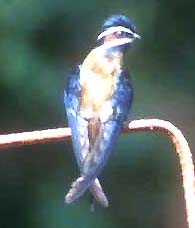 One
or two seen perched up in the canopy on most days at BRL; one pair perched
on the crossbars of the canopy walkway for nice photos. I was alone and
being very quiet at the time, otherwise they were skittish. We never saw
any on the walkway supports when other people were present.
One
or two seen perched up in the canopy on most days at BRL; one pair perched
on the crossbars of the canopy walkway for nice photos. I was alone and
being very quiet at the time, otherwise they were skittish. We never saw
any on the walkway supports when other people were present.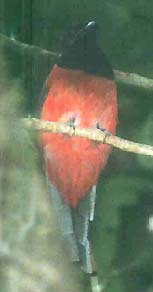 Single
males were inside the forest at DVFC & BRL; the latter was photo'd
with flash (right). Males have deep pink nuchal bands.
Single
males were inside the forest at DVFC & BRL; the latter was photo'd
with flash (right). Males have deep pink nuchal bands. The
full-out call of this spectacular hornbill is my choice for the 'best bird
vocalization' in the world. Deep measured hoots slowly accelerate until
the bird breaks out into loud maniacal laughter; when heard the first time
the change in tone is so unexpected that it is a real shocker. It is sooo
fabulous to hear this while walking in beautiful rainforest; and we heard
it most days at BRL. Early one morning we caught a ride to the entrance
gate at BRL and walked back. During that walk we had incredible views of
a pair perched (distant male perched, right) and in flight and calling.
Wow!
The
full-out call of this spectacular hornbill is my choice for the 'best bird
vocalization' in the world. Deep measured hoots slowly accelerate until
the bird breaks out into loud maniacal laughter; when heard the first time
the change in tone is so unexpected that it is a real shocker. It is sooo
fabulous to hear this while walking in beautiful rainforest; and we heard
it most days at BRL. Early one morning we caught a ride to the entrance
gate at BRL and walked back. During that walk we had incredible views of
a pair perched (distant male perched, right) and in flight and calling.
Wow!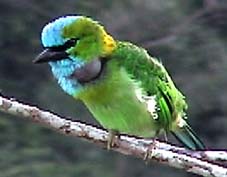 This
is the 'easy' Bornean endemic barbet. It is heard constantly at GK. Yet
seeing one is another matter! THE spot is the gate for the GK hike at the
end of the summit road. Here they are very used to people and we had great
views every day we were there. Rita has fantastic video of a calling bird
(Rita's vid-cap right). As they call the males use puffed-out throat
air-sacs that recall tree frogs or American grouse!
This
is the 'easy' Bornean endemic barbet. It is heard constantly at GK. Yet
seeing one is another matter! THE spot is the gate for the GK hike at the
end of the summit road. Here they are very used to people and we had great
views every day we were there. Rita has fantastic video of a calling bird
(Rita's vid-cap right). As they call the males use puffed-out throat
air-sacs that recall tree frogs or American grouse!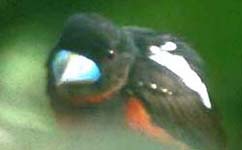 One
perched in a riverside tree was a highlight of our Mulu visit; other birders
there found nests along a side tributary. Rita had another in the garden
at Poring. At BRL we often saw 2-3 in the garden and photo'd one from the
boardwalk next to our room (right).
One
perched in a riverside tree was a highlight of our Mulu visit; other birders
there found nests along a side tributary. Rita had another in the garden
at Poring. At BRL we often saw 2-3 in the garden and photo'd one from the
boardwalk next to our room (right). This
much-wanted species — recently elevated to its own monotypic family — was
finally seen on day 5 (of 8 planned) at BRL. Three were first heard (by
Wangkong) and then seen hopping about the larger limbs on tall canopy trees
along the access road. We heard others both at BRL & Sepilok but they
did not respond to taped calls. A major highlight of the trip.
This
much-wanted species — recently elevated to its own monotypic family — was
finally seen on day 5 (of 8 planned) at BRL. Three were first heard (by
Wangkong) and then seen hopping about the larger limbs on tall canopy trees
along the access road. We heard others both at BRL & Sepilok but they
did not respond to taped calls. A major highlight of the trip.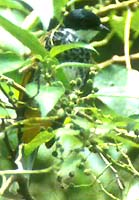 Two
eating fruit in the BRL garden posed for photos and video. Another cool
bulbul.
Two
eating fruit in the BRL garden posed for photos and video. Another cool
bulbul.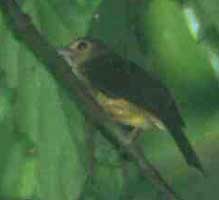 Pairs
encountered regularly with flocks or alone inside forest at BRL (one photo'd
with flash; right) and Mulu; also recorded Sukau.
Pairs
encountered regularly with flocks or alone inside forest at BRL (one photo'd
with flash; right) and Mulu; also recorded Sukau. Pair
eating fruit in the BRL garden (photo'd).
Pair
eating fruit in the BRL garden (photo'd). Heard
often on GK but only a few seen. On first hearing the song I did not expect
a tailorbird at all!
Heard
often on GK but only a few seen. On first hearing the song I did not expect
a tailorbird at all!
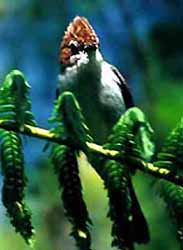 Common
at GK where flocks of 20+ birds — often by themselves — are encountered.
Also seen much lower down at Poring and one was in a mixed flock near Deer
Cave at Mulu which is very much in the lowlands. This is among the easier
Bornean endemics to find.
Common
at GK where flocks of 20+ birds — often by themselves — are encountered.
Also seen much lower down at Poring and one was in a mixed flock near Deer
Cave at Mulu which is very much in the lowlands. This is among the easier
Bornean endemics to find.
